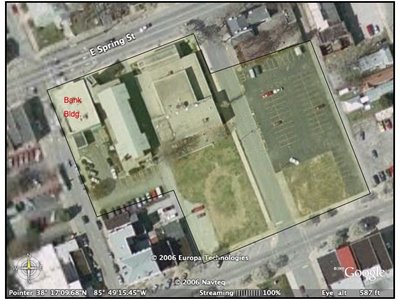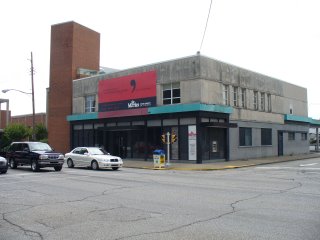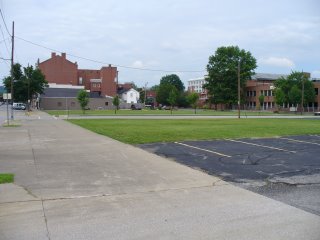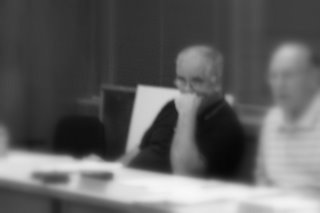 See preceding post for the text of the ordinance discussed here.
See preceding post for the text of the ordinance discussed here.----
There may not have been a more brazenly shameless and fatuously disingenuous lie told by an American politician since Dick Nixon said, "I am not a crook.”
And yet the Big Lie reposes in majestic malevolence, awaiting its turn in the spotlight on Monday night even as it grows like Pinnochio’s elongated nose, right there within the opening stanzas of the latest in a series of absurdly reneging “kill Scribner Place and keep New Albany backward” city council resolutions that will continue to be issued like Rally’s belchburger coupons so long as the Gang of Four has a faint electoral pulse – this new one offered by councilman Bill Schmidt, but almost guaranteed to have been written by CM Schmidt’s longtime household numerologist, and one that at any rate is as brutally cynical as any scratch pad memo ever composed by Karl Rove:
“WHEREAS, the New Albany City Council is in support of the Scribner Place Project … ”
Followed closely by a second breathtaking whopper:
“WHEREAS, it is the responsibility of the City Council to support the progress of the downtown area … ”
Accordingly, somewhere in the furthest reaches of Hell, Herr Goebbels is smiling.
Broadly.
Can any reader – can any resident of New Albany, or for that matter, any human being – provide documentary evidence from the public record during the past two years to buttress the phantasmagoric notion that either CM Schmidt alone or the council’s Gang of Four as a whole has “supported” either Scribner Place specifically or the “progress of the downtown area” as a general aim?
(crickets chirping, pins dropping)
I didn’t think so, but that’s all right. It wasn’t fair of me to ask a question that is logically impossible to be answered in the affirmative.
CM Schmidt’s breathtakingly mistaken version of council – and municipal – reality is so utterly devoid of viability that there can be no explanation for its short-circuited inanity apart from a pleasure trip to Rod Serling’s Twilight Zone or serial psychotropic drug use.
Earlier today, my friend and co-editor Randy used the word “offing” to describe the surreal, gleeful manner that CM Schmidt is divesting himself of what remains of his previously passable legacy of public service, and speaking personally, the difference between CM Schmidt’s disintegration and the antics of the Siamese “Boner and Jethro” Councilmen is that from the very beginning, I’ve really wanted to like him. I still do.
However, over and over again, stemming from an ancient grudge or an undiagnosed animus, or perhaps the cantankerousness of old age … or sadly, and far more likely, owing to the accumulated weight of bad information that’s constantly been given him by those who would mistake the ability to hammer a nail for the skill to design a building, CM Schmidt has chosen to lovingly embrace the dark side, and has consistently voted against hope.
So have three others, and it’s a pathetic commentary on the city of New Albany that the Democratic Party continues to sanction this sort of unmitigated civic cannibalism. Seeing as I have no children of my own, can someone please help me understand how it is that grandfathers happily vote against the interests of their own grandchildren?
At this point in time – a full year after Scribner Place presumably was settled – it is impossible for any person of reasonably sound mind and functional body to fathom the purely chemical processes seeking to pass muster as “thought” on the reactionary side of the council table.
Apparently there comes a time when personal honor, common rationality and self-interest no longer figure into the equation, and the Gang of Four, led by the forever caterwauling Dan Coffey, seconded by one-tune-pony Steve Price and abetted by Schmidt and fellow Neroesque grandee Larry Kochert, have fairly pole-vaulted over this line of demarcation not just in attempting to thwart economic, social and municipal progress, but to openly deride and to laugh aloud at those in the community who’ve been working to reverse New Albany’s history of underachievement, and for the first time in decades, have been making strides in the direction of doing so.
Ironically, and shamefully, at a time when surrounding communities from Clarksville to Corydon have jumped to read the tea leaves and are eagerly embracing progress, these four community leaders desire nothing so much as the continued personal power to reject the 21st century and to hold the future hostage to naked fear, undisguised loathing and fratricidal personal animosities so powerful and enduring that Balkan blood feuds look like a formal English garden party by comparison.
To repeat, CM Schmidt’s capitulatory resolution seeks to establish that the city council has supported “progress of the downtown area?”
Exactly what measures has Schmidt’s side of the council table proposed toward this end? Neither plan nor strategy emanates from their quarters – just niggardly doubts and nattering negativism. Never have there been heard encouraging words from the Gang of Four – just rancor and expressions of distaste and distrust for those who dare to formulate plans and strategies.
Nothing positive, ever. They can only impede, block, and malign. It’s a travesty, it’s embarrassing, and it’s way past time that the genuinely capable in the city of New Albany join together in whatever form is necessary, politics be damned, to do what must be done to correct the injustice.
For reasons known only to the Gang of Four and to a relatively small band of dysfunctional, envious confederates, councilmen Coffey, Price, Schmidt and Kochert are endeavoring to hold back the only forces of rational, reality-based change that stand any chance at all of helping to make this community a better place to live and work, and even if the odds of reversing decades of neglect and befuddlement are only 50/50, that’s fully 100% more real hope than any single member of the council’s Gang of Four congenital obstructionists have offered the city to date.
Civilization as we know it has evolved owing to the willingness of millions of ordinary people from time immemorial to take deep, symbolic breaths and plunge boldly forward … and seldom because the effort and sacrifice required to do so has held the slightest promise of material benefit in their own contemporary lives.
That’s because it’s not about us – at least any of us currently reading, working, taxpaying and consuming.
Already, inexorably, irreversibly, it’s about very young children, and others yet to be born. The sooner that we all understand that, the better – but considering the Gang of Four’s impossibly long learning curve, we’d best not hold our breaths, and instead work to ensure that whatever the outcome of councilmen Schmidt’s and Coffey’s dishonorable, reneging, anti-everything resolutions, that their retirement from the political scene comes sooner rather than later.
2007?
That’ll have to be soon enough. Let’s hope we can minimize the damage -- to the city, to the children, and to the future -- until then.
----
In closing, this goes out to Anna: Try as some might to make numerical entities dance the gavotte, to read spreadsheets like they were lovelorn Shakespearean sonnets, and to substitute variable accounting practices for the simple wisdom one derives from a hard day’s toil, they’re all useless when it comes to mapping the aspirations of the human spirit.
Aspirations like these -- hopes, dreams, wonderment -- are alive and well in New Albany, and you are dedicating your husband's council career to smothering them.
Why is that?














